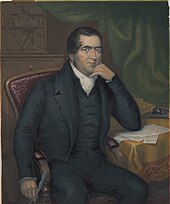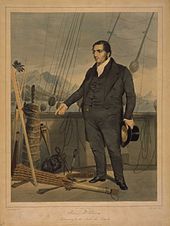John Williams (missionary)


John Williams (born June 29, 1796 in Tottenham , † November 20, 1839 in Erromango , Vanuatu ) was a British non-conformist missionary who was active in the South Pacific.
Life
After training as a foundryman and locksmith, the London Missionary Society appointed Williams a missionary at a service in London's Surrey Chapel in September 1816 . In 1817 he and his wife Mary Chawner traveled to the Society Islands , a group of islands to which Tahiti also belongs. They were accompanied by William Ellis and his wife. John and Mary established their first mission on the island of Raiatea . From here they visited some of the Polynesian island chains, sometimes accompanied by the Ellis family or other representatives of the London Missionary Society . In 1821 they landed on Aitutaki and used Tahitian converts to get their message across the Cook Islands . The island of Rarotonga was discovered by Captain John Dibbs , who commanded the colonial schooner Endeavor , in July 1823. Williams, who traveled on board, set up a mission station on the island.
John and Mary had ten children, three of whom reached adulthood. The Williams' were the first missionary family to visit Samoa .
The Williams' returned to Great Britain in 1834, where John had his translation of the New Testament into Rarotongan printed. They brought with them a native named Leota from Samoa, who later lived as a Christian in London. Leota was buried in Abney Park Cemetery . The tombstone donated by the London Missionary Society tells of his journey from the South Seas. In London, John Williams published the work "Narrative of Missionary Enterprises in the South Sea Islands", which contributed to the knowledge of the English and their popularity. In 1837 he returned to Polynesia on the Camden under Captain Robert Clark Morgan .
In November 1839 he visited part of the New Hebrides . He and the missionary James Harris were killed here on November 20th on the island of Erromango and eaten by the cannibals .
A memorial stone was erected on Rarotonga in 1839. His wife died in June 1852. She is buried in London's Abney Park Cemetery with her son Samuel Tamatoa Williams, who was born in the New Hebrides . Her husband's name and the story of his death are depicted on the most visible side of the tomb.
In December 2009, descendants of John and Mary Williams traveled to Erromango to receive apologies from the descendants of the former cannibals during a reconciliation ceremony. For the occasion, Dillons Bay was renamed Williams Bay .
The mission ship John Williams was named in his honor.
Fonts
- John Williams: A narrative of missionary enterprises in the South Sea Islands; with remarks upon the natural history of the islands, origin, languages, traditions, and usages of the inhabitants. Illustrated with engravings on wood by G. Banter. Europeana, accessed February 16, 2016 .
literature
- Tom Hiney: On the Missionary Trail. A journey through Polynesia, Asia and Africa with the London Missionary Society. Atlantic Monthly Press, New York 2000, ISBN 0-87113-823-9 .
- Ebenezer Prout: Memoirs of the Life of the Rev. John Williams, Missionary to Polynesia. John Snow, London 1843. (PDF; 90 MB). (Other edition: Dodd, New York 1843: online ).
- Norman B. Springlane : Williams, John. In: Biographisch-Bibliographisches Kirchenlexikon (BBKL). Volume 13, Bautz, Herzberg 1998, ISBN 3-88309-072-7 , Sp. 1332.
Web links
Individual evidence
- ^ Hugh Chisholm (Ed.): Williams, John, English Nonconformist missionary . Encyclopædia Britannica (11th edition) Cambridge University Press 1911. Digitized at Wikisource
- ↑ Wills & Admons = Pt II, Kueck, John . q. v. Public Record Office (PRO). Retrieved February 6, 2010.
- ↑ James French: Walks in Abney Park Cemetery. 1888.
- ↑ BBC News - Island holds reconciliation over cannibalism , news.bbc.co.uk. December 7, 2009. Retrieved December 7, 2009.
| personal data | |
|---|---|
| SURNAME | Williams, John |
| BRIEF DESCRIPTION | British missionary in the South Seas |
| DATE OF BIRTH | June 29, 1796 |
| PLACE OF BIRTH | Tottenham |
| DATE OF DEATH | November 20, 1839 |
| Place of death | Erromango |

